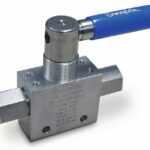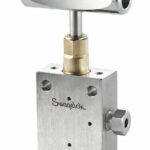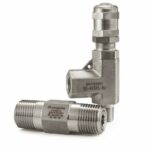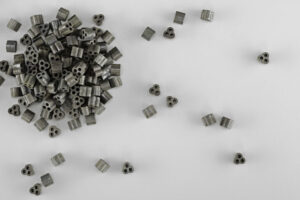Valves for hydrogen applications must fulfil a wide range of requirements. The small size of hydrogen molecules – one of the smallest naturally occurring molecules on earth – requires specialised fluid systems to contain them. Avoiding safety risks in hydrogen systems is of critical importance for both producers and consumers, so each connection within the system must be leak-tight. In addition, any leaks from vehicles and fueling systems are simply wasteful.
But leaks are not the only challenge posed by hydrogen. When lower-quality stainless steel components are used, the hydrogen may diffuse into the stainless steel and thus weaken the components to the point where they may prematurely fail. This process is known as hydrogen embrittlement.
And there are some more aspects to consider when selecting a hydrogen valve:
- Pressure: To achieve the desired density, hydrogen must be stored in on-vehicle tanks at 350 to 900 bar
- Stress and vibration: Systems must be able to withstand fast speeds, bumpy roads, and inclement weather conditions
- Safety: Refueling stations must be safely operable by the average consumer
- Maintenance: It should be easy to remake leak-tight joints during servicing
The valves selected for hydrogen transportation infrastructure should meet the requirements above to function at the highest levels. Leak-tight performance is essential at all connection points and shut-off or regulation points. Valves must also be able to handle operating in conditions that are prevalent in hydrogen applications.
Typically, three different kinds of valves are used in hydrogen systems: ball valves, needle valves and check valves. What is important when selecting the right design is explained below. In addition, it is advisable to choose a supplier with the necessary experience who can offer comprehensive consulting services in this area and a broad product portfolio.
Ball valves
Commonly deployed in hydrogen systems to start and stop the flow from one direction to the next, ball valves are crucial to ensure a well-functioning hydrogen system. One of the most important considerations for selecting the right ball valve for hydrogen applications is finding one that can stand up to the rigors of the system without degradation. Perhaps the best option is a trunnion-style ball valve with a direct-load design. Valves designed to this specification will help create leak-tight hydrogen flow each time the system is activated or closed. In addition, it may be helpful to find a valve with a bottom-loaded stem design to avoid stem blowout and enhance the overall safety of the system.
If there are any questions about whether the chosen valve is appropriate for the application, a reputable valve supplier should be able to answer them. Most ball valves can be configured with two- or three-way functionality, direct mounting options, and a range of flow coefficients that can be customized to fit your needs.
Needle valves
To make fine adjustments to how much hydrogen is flowing at any given time, needle valves are often used. As with ball valves, needle valves used in hydrogen systems have specific requirements to work properly. Usually, needle valves are made entirely of metal, which means they require significant force to seal them completely. Unfortunately, using that much force can deform the needle and potentially the body seat. When this occurs, it creates potential hazards and costly repairs. In addition, the force is typically applied by using large air or electric actuators. However, electric actuators are slow to fully deploy and can take up to two minutes to operate at full capacity.
Since the strains put on needle valves cannot be avoided, it is critical they are made from high-strength, hydrogen-resistant material because it can reduce the amount of damage done with each use. Needle valves should be certified for high-pressure environments because most needle valves operate under 350 to 900 bar of pressure in hydrogen applications. As mentioned above, needle valves should also be able to pass hydrogen-compatibility tests to ensure leak-free use.
Check valves
Finally, check (nonreturn) valves are deployed in hydrogen refueling systems to prevent unnecessary backflow from affecting the end user. While check valves are commonly used in other industrial applications, some specific criteria must be met so they can function properly in a hydrogen system.
For example, check valves often contain springs, which are not usually rated to handle the problem of hydrogen embrittlement. Check valve springs should be made of high-quality 316 stainless steel to minimise this problem. Temperatures and pressures often change significantly and quickly during refueling and put even more stress on the check valve’s elastomer seals. Therefore, it may make more sense to choose ball check valves for hydrogen compressors. As with all valves, check valves should be tested to make sure they are compatible with other components in the system to ensure the safety of end users.
Swagelok Company, Solon, Ohio, USA













